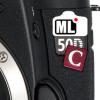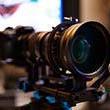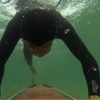
Brian Caldwell
-
Posts
153 -
Joined
-
Last visited
Reputation Activity
-
 Brian Caldwell got a reaction from andy lee in P+S Thechnik Announces 35-70mm Anamorphic Zoom
Brian Caldwell got a reaction from andy lee in P+S Thechnik Announces 35-70mm Anamorphic Zoom
1.45x squeeze is an interesting choice given that they are aiming for 16x9 sensors. Almost identical to the old Iscorama, and will still require significant cropping to get from the resulting 2.6:1 down to 2.4:1 .
Also interesting is the 2-meter minimum focus. Perhaps they will be developing a large diameter diopter as an accessory?
-
 Brian Caldwell got a reaction from Julian in Possibly the rarest and most desirable glass on Ebay
Brian Caldwell got a reaction from Julian in Possibly the rarest and most desirable glass on Ebay
Patents pertaining to these lenses would have expired when Richard Nixon was still in office, and are now in the public domain. The Auto-Panatars date back to 1958, but Panavision switched from selling stuff to its current rental model back in the mid-1960's. That means that there should be quite a few of these in private non-Panavision hands.
-
 Brian Caldwell got a reaction from Andrew Reid in Possibly the rarest and most desirable glass on Ebay
Brian Caldwell got a reaction from Andrew Reid in Possibly the rarest and most desirable glass on Ebay
Patents pertaining to these lenses would have expired when Richard Nixon was still in office, and are now in the public domain. The Auto-Panatars date back to 1958, but Panavision switched from selling stuff to its current rental model back in the mid-1960's. That means that there should be quite a few of these in private non-Panavision hands.
-
 Brian Caldwell got a reaction from nahua in Speed Booster?
Brian Caldwell got a reaction from nahua in Speed Booster?
BMPCC-specific Speed Boosters have a magnification of 0.58x, and are only available in Canon-EF, Nikon-F, and Leica-R lens mounts. You could mount Yashica lenses to the Canon-EF BMPCC Speed Booster via a EF-C/Y adapter ring. Another possibility is to use the normal 0.71x m4/3 Speed Booster, which is available in a C/Y mount. However, you lose the extra speed increase and focal length reduction you get with the BMPCC-specific version. Also, the BMPCC version is optimized to work with the non-standard filter thickness of the BMPCC camera, which makes a difference if you are shooting with fast optics (e.g. f/1.4).
-
 Brian Caldwell got a reaction from andrgl in Speed Booster?
Brian Caldwell got a reaction from andrgl in Speed Booster?
BMPCC-specific Speed Boosters have a magnification of 0.58x, and are only available in Canon-EF, Nikon-F, and Leica-R lens mounts. You could mount Yashica lenses to the Canon-EF BMPCC Speed Booster via a EF-C/Y adapter ring. Another possibility is to use the normal 0.71x m4/3 Speed Booster, which is available in a C/Y mount. However, you lose the extra speed increase and focal length reduction you get with the BMPCC-specific version. Also, the BMPCC version is optimized to work with the non-standard filter thickness of the BMPCC camera, which makes a difference if you are shooting with fast optics (e.g. f/1.4).
-
 Brian Caldwell got a reaction from 1tkman in Speed Booster?
Brian Caldwell got a reaction from 1tkman in Speed Booster?
BMPCC-specific Speed Boosters have a magnification of 0.58x, and are only available in Canon-EF, Nikon-F, and Leica-R lens mounts. You could mount Yashica lenses to the Canon-EF BMPCC Speed Booster via a EF-C/Y adapter ring. Another possibility is to use the normal 0.71x m4/3 Speed Booster, which is available in a C/Y mount. However, you lose the extra speed increase and focal length reduction you get with the BMPCC-specific version. Also, the BMPCC version is optimized to work with the non-standard filter thickness of the BMPCC camera, which makes a difference if you are shooting with fast optics (e.g. f/1.4).
-
 Brian Caldwell got a reaction from dwijip in Blue spot in the middle of the FRAME (HELP!)
Brian Caldwell got a reaction from dwijip in Blue spot in the middle of the FRAME (HELP!)
Central hotspots are a ghost image of the aperture stop. They are caused by a pair of reflections between two surfaces located between the aperture stop and the image plane. Often this is a first reflection from the sensor followed by a reflection from one of the lens surfaces on the image-side of the aperture stop. However, it can also be caused by pair of lens surface reflections.
Because its a ghost image of the aperture stop it gets smaller as you stop down. If the ghost image is well focused and has low aberrations then it is possible to clearly make out the individual iris blades in the ghost image. The surface brightness of the spot remains constant during stop-down, only the size changes. But of course, as you stop down the overall image gets dimmer, so the relative brightness of the ghost image increases. So, hotspots are much more problematic at small apertures because they are smaller and better-defined and also because they are bright relative to the image content.
Hotspots are typically blue because the anti-reflective coatings of the lens are less efficient in the blue portion of the spectrum. Hotspots are also prominent in IR photography because coating performance is generally very poor in the IR. Improving the lens coatings can minimize hotspotting, but can't eliminate it. The best approach to avoiding hotspots is to design the lens in such a way that the pupil ghosts are very large and diffuse, and also to use the best possible lens coatings.
Hotspots were well known years before the Speed Booster first went on sale in 2013, and many lenses are well known to have hotspot problems.
-
 Brian Caldwell got a reaction from Francisco Rios in Official announcement - Metabones Speed Booster ULTRA
Brian Caldwell got a reaction from Francisco Rios in Official announcement - Metabones Speed Booster ULTRA
The fundamental problem is that the Speed Booster shrinks the vertex length of the lens (the distance from the front glass surface to the image plane). So even if you could mount the SB optics inside the C300 EF mount you wouldn't be able to focus to infinity because the EF mount protrudes too far. Even if you could design a focal reducer that maintained the vertex distance you would then have the problem of mounting the optics since an adapter approach wouldn't work (zero flange-to-flange distance).
-
 Brian Caldwell got a reaction from Andrew Reid in Official announcement - Metabones Speed Booster ULTRA
Brian Caldwell got a reaction from Andrew Reid in Official announcement - Metabones Speed Booster ULTRA
The fundamental problem is that the Speed Booster shrinks the vertex length of the lens (the distance from the front glass surface to the image plane). So even if you could mount the SB optics inside the C300 EF mount you wouldn't be able to focus to infinity because the EF mount protrudes too far. Even if you could design a focal reducer that maintained the vertex distance you would then have the problem of mounting the optics since an adapter approach wouldn't work (zero flange-to-flange distance).
-
 Brian Caldwell got a reaction from soundimageplus in Metabones Speed Booster for Micro Four Thirds - Review
Brian Caldwell got a reaction from soundimageplus in Metabones Speed Booster for Micro Four Thirds - Review
Yes, that's me. I really appreciate your extensive review, and the unexpected behavior with the original version of the Sigma 30/1.4 is certainly something I need to look into. The new version of the 30/1.4 is a really nice lens, BTW, and even though I only bought it for Speed Booster testing I'll definitely keep it since 21mm f/1.0 is really nice on m4/3.
-
 Brian Caldwell got a reaction from Andrew Reid in Metabones Speed Booster for Micro Four Thirds - Review
Brian Caldwell got a reaction from Andrew Reid in Metabones Speed Booster for Micro Four Thirds - Review
I co-authored that Metabones document, so I'm familiar with the figure :)
It makes no sense at all to me that your Sigma lens could vignette for video. That is, assuming that the width of the sensor's active area remains 17.3mm when in 16:9 mode. The Sigma has to cover a 28.4mm image circle for DX format, meaning that its image circle with the Speed Booster will be at least 28.4 x 0.71 = 20.16mm. A 16:9 rectangle that is 17.3mm wide has a diagonal of only 19.85, so something is definitely odd here. Does your m4/3 body have a variable active sensor width depending on the aspect ratio?
DX lenses we have tried on full micro four thirds format (21.6mm diagonal) with the Speed Booster without any obvious vignetting (at any aperture) include:
1) Sigma 30mm f/1.4 version II
2) Tokina 11- 16 f/2.8
3) Nikon 35mm f/1.8
4) Nikon 10-24mm f/3.5-4.5
The Sigma 8-16mm does have vignetting due primarily to its fixed lens hood shaped for 3:2 instead of 4:3.
I've also heard that the Nikon 17-55/2.8 works fine with no vignetting, although I haven't tried it myself




